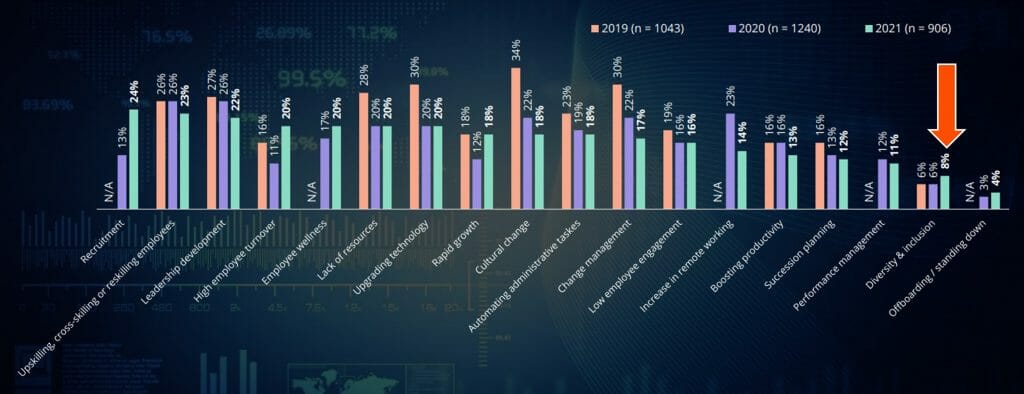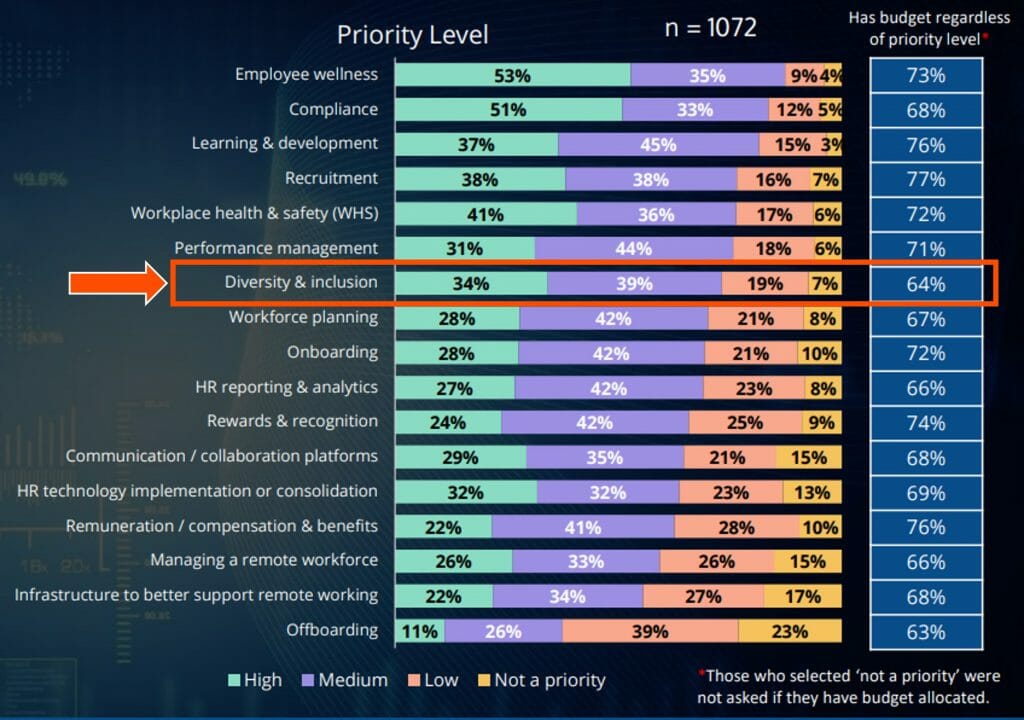How Committed to Diversity are Australian Organisations, really?
A look at how many Australian businesses are tracking the success of their D&I goals.
Promoting a diversity and inclusion culture is one of the key goals set for HR departments and business leaders. Many organisations state they strive towards this goal, and many do, but how important is diversity and inclusion to organisations overall objectives really?
How do organisations hold themselves accountable and put their money where their mouth is when it comes to championing diversity and inclusion? How many say they strive towards inclusivity but have no tools or processes in place to back up such a claim? How many just don’t bother at all? In this article, we will look at the data surrounding these factors to understand how investment in diversity and inclusion is progressing.
Setting and Achieving Diversity and Inclusion Goals
When we want to achieve a goal in our organisation, we take a strategic planning or project management approach by creating a strategy with actions that edge us ever closer towards achieving that goal. Your Diversity and Inclusion goals are no different and should be treated the same as any other commercial objective if they are to be achieved. Many organisations start out well with their Diversity and Inclusion initiatives, but a vast number of these initiatives prove ineffective or fail within a year or two. Why? The details and depth of strategic thinking behind them is as thin as the paper they are printed on.
This is unsurprising when you consider that most diversity and inclusion initiatives are developed to comply with corporate governance and self-regulation. For example, in many workplaces, these initiatives are usually poorly funded tactical inclusion initiatives disconnected from broader, more substantial, and well-funded general training programs. They may be well-meaning, but they are misguided in their approaches.
In ELMOS’s 2022 HR Industry Benchmark Survey, when respondents were asked, what metrics are used to measure success? Over 35% of HR professionals stated that engagement and retention were the top metrics, whereas only 14% stated diversity and inclusion targets as success metrics. If only they knew that diverse and inclusive organisations work 12% harder, are 19% more likely to stay longer with the organization, and collaborate 57% more effectively with peers.

Source: ELMOS Benchmarking Report
That leaves 86% of organisations not using diversity and inclusion as a success metric, so how can organisations truly promote a D&I culture if such a large majority don’t measure it at all? diversity and inclusion is far more than an “HR issue.” It should be a core ingredient in the design and execution of business strategy and embedded in the activities of the organisation day in, day out.
The key to driving results in workplace diversity lies in uncovering your employees’ passion points, channeling initial efforts toward those, and setting attainable diversity goals to match.
Take inspiration from the circumstances unique to your organisations. What is most relevant to your team may vary depending on your company size and industry, and factors that inflect diversity – like specific departments, seniority, and type of diversity (gender, ethnicity, background, disabilities, and more).
How To Track Diversity and Inclusion Success
“What gets measured, gets done” is particularly relevant for diversity and inclusion, because the biases that perpetuate workplace inequality are largely unconscious and automatic. Metrics help employers committed to diversity and inclusion stay on track by encouraging the identification and management of bias blindspots—mindsets and practices that promote homogeneity but which are largely hidden.
There is no standard or universal set of metrics to measure diversity and inclusion. Each company should take a personalised approach to decide which metrics they want to measure. The best, most effective diversity and inclusion metrics will be a blended approach that starts with representation measures — who have you hired, retained, and promoted — and adds data that provides insights into how inclusive the company culture is.
For example you might track:
- The diversity of employees v the diversity of your talent pool
- The diversity across organisation levels
- Job satisfaction and Job retention
Consider softer, non-obvious measures such as:
- Who is and isn’t talking in group meetings
- Who is and isn’t taking part in non-compulsory activities (team lunches, games)
- Males taking parental leave
Top Challenges for HR in 2022
When ELMOS’s survey asked what the top challenges for organisations will be in the next 12 months, only 8% of them stated that diversity and inclusion will be a challenge in 2022. We must ask what this means? Are organisations doing D&I so well that they don’t foresee any challenges or are they just blind to the challenge? The abovementioned 86% of organisations not using diversity and inclusion as a success metric would suggest the latter.
2022 Challenges:

When the survey asked about where diversity and inclusion sits in their list of priorities, 34% of respondents stated high (up from 31% in 2021) and 39% stated medium priority (up from 37% from 2021). When the survey asked about where diversity and inclusion sits in their list of priorities in terms of budget allocation, 34% stated high with 39% stating D&I as a medium priority.

In total that makes 64% of organisations dedicating budget to diversity and inclusion initiatives or technology in 2022. This is a positive sign, as although 86% are not setting KPIs for their D&I activity, the report shows that these 64% are investing in diversity and inclusion, either to continue or start their journey towards an inclusive and equal workplace.
Costs of Poor D&I
We must, however, call upon the remaining 26% (the 19% that stated low and the 7% that stated D&I as not a priority) that are trailing behind to review the benefits of diverse and inclusive workplace for their business (view guide here). We have provided a few below:
- 67% of job seekers say diverse workforce is important when considering job offers (Glassdoor).
- Organizations that prioritize diversity and inclusion are 35% more likely to have better financial returns than companies that don’t (McKinsey & Co.)
- Additionally, a study by Deloitte found that diversity and inclusion in the workplace can boost innovation by as much as 20%.
- Diversifying your team can help boost productivity by 35% (McKinsey & Co.)
D&I is an important factor for many of today’s job seekers, 70% of whom say. You can learn more about the benefits of improving your organisation’s D&I and how to roll out a strategy in our Guide to Diversity and Inclusion: Starting Out On The Journey eBook.
Now is not the time to be losing employees or candidates to lack of diversity
We are approaching a quarter of the way through 2022 (I know right?), Australian unemployment is currently sitting at 4% (the lowest it has been since the financial crisis in 2008), which means the job market is more competitive than it has been in the last decade.
The current cost to fill a vacant position is up 127% on the previous year and the number of days to fill a position has increased by 21% to 40 days.

2021 data shows that it can cost up to 33% of an employee’s salary to replace them and based on current average salary data that equates to an average cost of $19,000.
You can learn more about the cost of low engagement and replacing staff by downloading our Finding and Keeping Engaged Employees eBook.
Get in Touch
If you want to talk to one of our experts about how we can help drive your success with the right people, we are offering a gap analysis with on of our expert team. Simply sign up and book a time or contact hello@testgrid.com.
You can learn more about the importance of Diversity and Inclusion in Part 1 of our D+I Ebook series.
